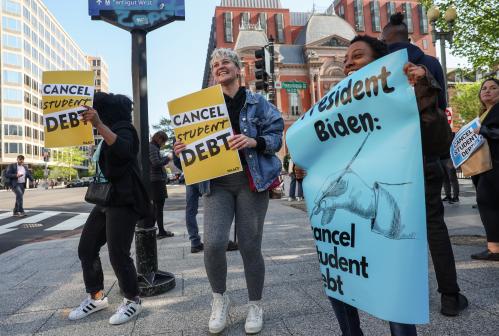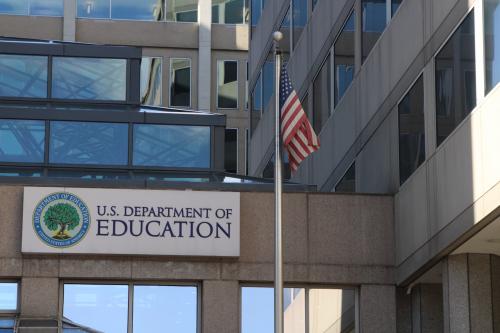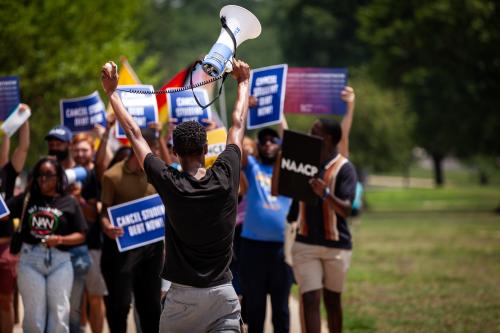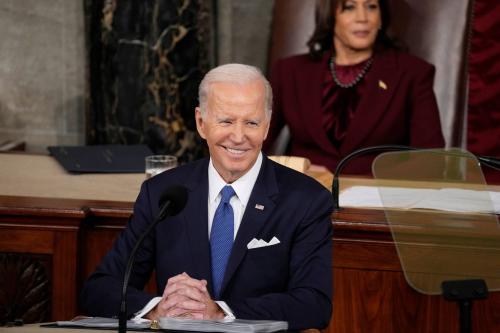It finally happened. After a year and a half of speculation and anticipation, the Biden administration decided to move forward with a large, but semi-targeted, loan forgiveness plan.
There are still a lot of questions pending about the details, but the policy has three main parts: First, it forgives up to $10,000 in federal loans for all borrowers with incomes less than $125,000 (and up to $250,000 for married couples) and forgives up to $20,000 in loans for students who attended college with Pell grants. This would reduce loans for 43 million people and eliminate loans for 20 million people.
Second, it modifies income-driven repayment (IDR) plans. While details may change, the current plan would lower the cap on repayment from 10 percent to five percent of discretionary income and lower the total discretionary income considered toward that cap. Also, for loans originally totaling less than $12,000, remaining balances would be forgiven after 10 years (down from 20 years). Third, it extends the COVID moratorium “one last time” to January. These changes apply only to federal loans, not private loans.
But, really, this announcement is just the beginning. Turning this announced policy into productive practice will be a complex, high-wire act if ever there was one—there are risks on the left and the right that could lead Democrats to fall off the wire but also a narrow possible path forward where they can stay on it. Really, it’s three different high-wire acts in one: legal, rhetorical, and political.
On the legal front, there is a question of constitutionality. On the rhetorical front, Democrats can’t seem to agree on why they are doing this, and some of their arguments play into Republican hands. On the political front, there are issues beyond just how much this energizes the Democratic base. In particular, few seem to have realized yet that a large share of the fiscal cost, in the long run, will go not to immediate loan forgiveness, but to what is, in effect, a large new federal grant program.
The Legal High-Wire Act
The most immediate issue is the reasonable chance that the policy will never go into effect. Opponents are looking for a plaintiff who has legal standing to make a case. At issue is that the executive authority that Biden claims to provide this loan forgiveness comes partly from the Higher Education Relief Opportunities for Students Act of 2003, which grants the education secretary the power to “alleviate hardship” in a time of national emergency.
Is this a national emergency? And is the policy narrowly tailored to address it? It wasn’t hard to use this law to justify a pause on loan payments during the pandemic, but that emergency has largely passed. You could argue that an ongoing emergency still exists for some people (e.g., those who lost a relative to the pandemic), but the loan forgiveness policy isn’t tailored to that group. This is presumably why both the Speaker of the House, Nancy Pelosi, and the President himself both expressed their own legal qualms.
While I’m not a lawyer, it doesn’t take an expert to realize that the current Supreme Court is on guard against anything that hints at executive overreach. And this legal high-wire act is important even if the policy does pass legal muster. If the President has legal authority to do this, then we must ask the question, what happens if a Republican becomes President? I write more on this below under the political high-wire act.
The Rhetorical High-Wire Act
To see Democrats’ rhetorical high-wire act, consider the four divergent, and sometimes questionable, arguments being made in favor of the policy:
1. Loan forgiveness addresses the rising price of college and making it more affordable. If you read the President Biden’s remarks at the announcement ceremony, without knowing who wrote them, you might think they came from a (pre-Trump) Republican. “The total cost to attend a public four-year university has tripled—nearly tripled in 40 years—tripled,” President Biden said. Republicans often make similar claims when criticizing “out-of-control college spending” and looking for arguments to make spending cuts.
This exaggerates the problem, however. It’s true that the published “sticker price” of public four-year public colleges has tripled, but the prices of other types of colleges have risen more slowly and real net prices—the prices students actually pay and take loans on—have risen much less. For example, one paper shows that net prices at two-year public colleges and private four-year colleges have been essentially flat for most of the last 25 years, especially when excluding room and board. Some increases have occurred at four-year public colleges, but nowhere near tripling. One reason for the continued misunderstanding is that the posted prices are higher than the actual prices students pay after accounting for grant-based financial aid. Another study comes to a similar conclusion in more recent years and points to the increasingly progressive pricing policies of colleges through high-aid models. This doesn’t mean college is as “affordable” as it ought to be, or that the sticker price is unimportant, but we shouldn’t exaggerate either.
2. Loan forgiveness makes good on an implicit “social contract” with students. Here, the idea is that society has been telling young people to go to college by any means necessary. So, they went to college. But graduation rates are low, especially at two-year colleges. And to pay for college, students had to borrow, with a complex and dysfunctional loan system. In this sense, government policy set students up for failure. This was essentially the argument that Sue Dynarski made powerfully in the New York Times. Loan forgiveness redresses past policy failures. You broke it, you fix it. There is certainly truth in the idea that the aid system is broken, but this argument, too, plays into Republican talking points about the problems with government.
3. Loan forgiveness addresses the economic “natural disaster” of the past 15 years. The system would have worked better if not for the 2008 financial crisis, and now COVID, which got in the way and made it difficult for students to make payments. In this sense, the “student debt crisis” is much like a hurricane or a tornado that affects people through no fault of their own—and the government is stepping in as a kind of social insurance. (Dynarski also makes this argument, among others.) The 2008 financial crisis did have a long-term effect on employment and earnings that has made the debts pile up. This argument could call for more mass loan forgiveness since essentially all types of debts were affected by both crises.
A related argument, made by President Biden’s Secretary of Education, Miguel Cardona, is that the policy was intended to address the economic effects of the pandemic. This argument is difficult to follow, however, because: (a) it suggests a need to stimulate the economy at a time when it’s overheating; and (b) the main COVID targeting of the President’s plan is the end of the payment pause—that is, it removes, rather than adds, a COVID-related benefit.
4. Loan forgiveness helps a lot of poor people and people of color. Economists typically measure progressivity/regressivity by the share of benefits going to people in different groups. The only estimate I can find based on the administration’s recent proposal suggests that the policy is modestly regressive (a larger share of the funds go to higher income groups). The policy is more progressive by race mainly because by targeting some forgiveness to Pell students, a larger share of funds goes to Black students. Other estimates suggest that the average Black borrowers will have their student loans cut in half and one in four will have their loans wiped out completely.
Bottom line: Democrats have a problem here. Two of the arguments being made by the administration are questionable. The supposed explosion of college prices also plays into the hands of Republicans who want to lambaste colleges and universities with false accusations of administrative bloat and inefficiency. The President, in his remarks, tried to pin this on the decline in support from state legislatures, but this is only partially true and the distinction between costs and prices is too subtle for public consumption. And even setting aside the validity of these arguments, Democrats aren’t all singing the same tune. Each day brings a different argument and the inconsistent messages have allowed opponents to argue that the decision was a political handout.
The Political High-Wire Act
The worst-case scenario for Democrats is that the policy is judged to be unconstitutional. In that case, Democrats are back to square one—but with 43 million upset student borrowers who thought their loans would be forgiven.
But let’s suppose the policy turns out to be constitutional. Loan forgiveness is not the kind of clear political winner that political parties love. Rather, it’s the type that excites the political base—in this case, young, college educated adults, especially people of color—and that might increase turnout in the midterms and beyond. But independents are evenly split on it.
What about the long run? Given the obvious legal questions, the President must have believed that the policy announcement would be good for the party even if it gets overturned in the courts. The policy has many parts and some could survive even if courts scrap others. Also, the announcement will keep this topic in the headlines and may force the hand of Congress to “do something.”
But if it is constitutional, there is also the risk that future Republican presidents will undo Biden’s policies. No doubt Republican candidates would promise to do just that. Democrats are probably also calculating that Republicans wouldn’t actually undo the policy, for the simple reason that taking benefits away is a lot harder than granting them to begin with (see the entire history of Social Security)—and many Republicans have student loans, too.
The New Federal Grant Program
Another reason public support might shift over time is that the current focus is on the $10,000 to $20,000 in immediate forgiveness of existing loans. But, in the long run, the changes in the IDR loan policy may be more important. They constitute essentially a new grant program.
To see why, consider three key parts of the announced plan: (a) the reduction in the maximum payment from 10 percent to five percent of discretionary income (for undergraduates only); (b) the forgiveness of remaining debt after 10 years (from the previous 20 years), for loans originally totaling less than $12,000; and (c) the change in the definition of discretionary income so that any income under 225 percent of the poverty level would have no payment. For a single person, this is roughly $29,000 per year.
How these provisions affect students depends on three main factors: their future income, the loan totals, and degree types. The following tables summarize how different groups are affected on these dimensions. The first column distinguishes income levels and degree types. (I assume, though the policy guidance is unclear, that this same level of non-disposable income will apply to other students.)
Table 1: Key Components of President Biden’s Income-Driven Repayment Plan
| Loans < $12,000 | Loans > $12,000 | |
| Future income < 225 percent of poverty (undergrads) | No repayment | No repayment |
| Future income > 225 percent of poverty (undergrads) |
Five percent of income max payments Balance forgiven after 10 years |
Five percent of income max payments Balance forgiven after 20 years |
Now, obviously, students don’t know their future incomes, so the actual required repayments are based on their expectations. Still, this table helps us understand what incentives students face.
First, students who think they have some chance of ending up with low incomes have a strong incentive to borrow because all the loans would be forgiven. Even for those who strongly expect higher incomes, loans are still more attractive now. Let’s consider two scenarios for the higher-income groups:
- Middle class future income. Suppose these students end up with total annual income of $50,000 per year. They would apparently pay a maximum of ($50,000-$29,000) x 0.05 = $1,050 per year. (The $50,000-$29,000 calculation reflects that not all total income is discretionary.) Over 10 years, this would sum to $10,500. There would be a strong incentive to stay under $12,000 in total borrowing, because failing to do so doubles the maximum repayment period to 20 years, but the reduction of the annual repayment maximum to five percent still increases the incentive to borrow at higher levels, too.
- High future income. Someone who earns $75,000 and has loans above $12,000 would pay up to $2,300 per year or a maximum for 20 years, or $46,000 over 20 years. For students who were planning to go to expensive colleges (e.g., competitive private colleges), this would create a strong incentive to take out massive loans—everything above $46,000 would be forgiven.
Again, there are a lot of details that the administration still has to work out. But it’s clear that, under just about any implementation of the plan, most people will have incentives to borrow more (and no one has an incentive to borrow less). So, the first effect of this of this “loan forgiveness” policy is going to be raising debt levels.
The second effect will be to raise both sticker and net prices to some degree. This is Econ 101. Price subsidies—in this case, the new IDR rules—increase demand and that increases prices to some degree.
Third, and finally, the forgiveness of loans under IDR is money given to students that does not have to be paid back, it is essentially a large new, semi-means-tested federal grant program. That might make sense as part of the point of IDR is to reduce the risk, but the high-income case above reinforces that this plan goes beyond risk reduction. The scale of the policy change has not been fully recognized.
Bottom Line
Democrats face risks on all sides. They face the legal risk that the policy will be overturned. They face the political risk of blame for raising college prices further. And they face the risk that their own rhetoric about rising prices will come back to bite them. Republicans will likely quote President Biden for years to come about prices being out of control, shifting voters’ ire to colleges and universities.
But this also suggests why the administration is taking the risk. Republicans have supported IDR plans in general, so rooting this policy change in IDR plans has the veneer of bipartisanship. IDR plans also maintain the center-right principle that students should pay some of the costs and have “skin in the game.” It also fits the political left’s desire for larger government subsidies and reduced college prices without cutting total resources to colleges. As political alliances go, this is not a bad start.
The President’s subsidy-oriented proposal also avoids cutting overall college resources. Republicans more often see such cuts as the path to college affordability, but starving colleges would be shortsighted. Neither prices nor costs have been rising as much as people think. Also, higher education is the best and surest investment we can make, as individuals and as a country. There are few areas where we can say we are clearly the best in the world. Higher education is one of them and cutting resources would undercut that. The President’s plan avoids this pitfall.
Perhaps the strongest argument for the President’s plan is that there may be no other feasible way to meaningfully improve affordability. State legislatures seem unwilling to raise taxes to rebuild state funding to public colleges and universities. The President’s free community college couldn’t get through Congress even with nominal Democratic control of the White House and Congress. We can keep raising the Pell grant—another policy with broad support—but this doesn’t address affordability for the middle class. And there seems to be little appetite from either party to regulate prices. What’s left? More generous income-driven repayment.
Like any high-wire act, there is a narrow path to success that comes with big applause from the crowd. The question is, can Democrats maintain their balance on the wire until they get to the platform on the other side? Time will tell whether Democrats can, or even should, make loan forgiveness part of their own platform.







Commentary
Democrats’ high-wire act on student loan forgiveness
September 20, 2022